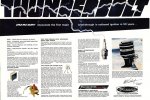Re: Spark plug question for 76 Mercury 1150
I am not a plug designer, but over the years I have messed with plugs in different engines. I have a semi modern Merc 90 and in the service manual it lists a SG as standard and a conventional gapped plug as an alternate but it is listed because it has a RFI filter coil imbedded in it for folks with sensitive electronics on board needing some RFI protection.
I have run both in my engine. After some fooling around I decided to leave the SG's in. Reason being the gap. The gap for the conventional is spec'd at .040 and my measurement of the SG came to .060.
The SG is a self cleaning plug and electrode wear is minimum. On the cooler running plugs in these engines, electrode wear is a no brainer anyway. I had none on my conventional gaps or the SGs.
From an energy perspective, The CDI has the ability to deliver a 40 kv pulse, in 4 microseconds as I recall. That's one heck of a lot of whoopie in a very very short time. That would occur in an open circuit but before the plug fires it is an open circuit so that is the shape of the leading edge of the potential 40kv pulse as it is supplied to the plug and rises over the plug gap.
Since the energy is stored (1/2 CV exp2) and used as the square of the voltage, the higher the voltage, the higher the energy but the energy level is the square of the voltage. So, for the energy contained in the spark at the time a .04 gap breaks and a .06 gap breaks you have a 50% increase in voltage (considering a linear kv/inch scale) but a 225% increase in energy in the spark at the firing time.
Therefore a surface gap has better than a 4x chance of firing a contaminated plug. Wink! I think OEM's are onto something as I know OMC and Merc used them for a lot of years. I had them in my OMCs and my Mercs. Don't know about any other brand.
The reason I started thinking about what I said above is one day I was troubleshooting a problem and happened to substitute a SG plug for the conventional. The difference in the spark intensity and snap caught my attention and I got to thinking about just why was that. Well, as I see it that's why.
On cool running, this is just speculation, but I think it is part of pre ignition reduction on being able to use the lower octane gasolines. Pre ignition can burn some bad holes in an alum piston. Have seen pictures of it, both 2 and 4 stroke engines.
My 2c,
Mark




















